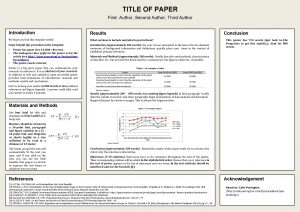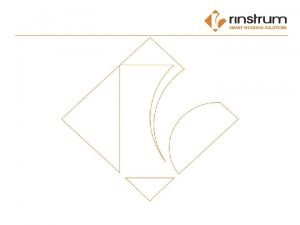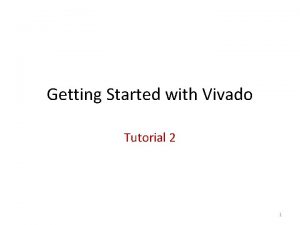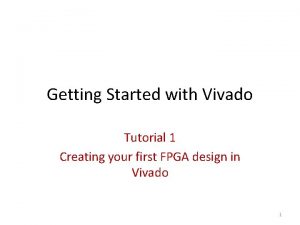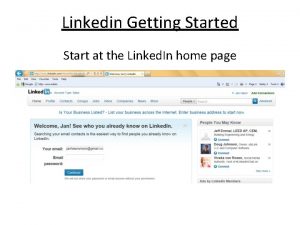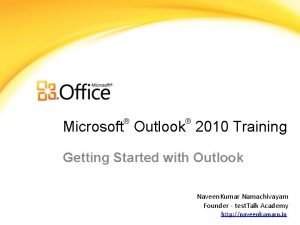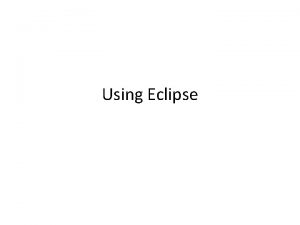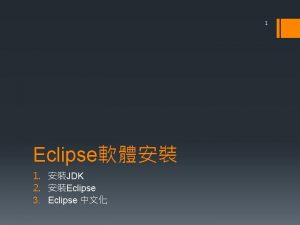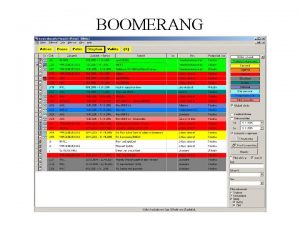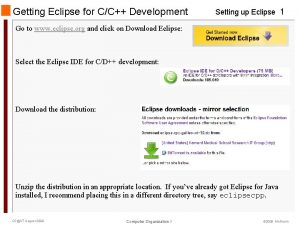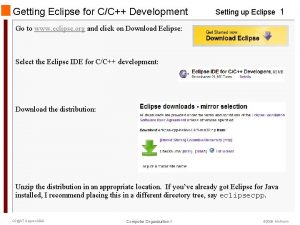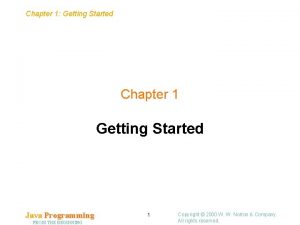Getting started with Eclipse Author Loh Jianxiong Christopher






















- Slides: 22

Getting started with Eclipse Author: Loh Jianxiong Christopher Contributions: Chua Jie Sheng, Li Mengran, Peh Shao Hong, Oo Theong Siang, Tong Chun Kit, Tania Chattopadhyay

Introduction to Eclipse A powerful IDE (Integrated Development Environment) Provides many features and tools to aid in software development Download the latest version of Eclipse from: http: //www. eclipse. org/downloads/ 2

Starting Eclipse When you first start Eclipse, you will be asked to set a workspace folder, which is the location where all your project related files will be stored 3

Creating Hello. World Project On the top menu bar, click: File New Project. [For Mac Users] If New menu is empty, right click on a blank area of the Package Explorer. (See Next Slide) 4

Creating Hello. World Project (Mac Users) Right-click on the blank area of Package Explorer, click: New Project. 5

Hello World! Select “Java Project” from the wizard, and click “Next>” 6

Hello. World Type in our project name “Hello. World” and click “Finish”. 7

The Workbench That should bring you to the ‘Workbench’. It has following main components. The package explorer pane displays the various files (some source, some bytecode) included in your project in the form of a tree. Click the triangular buttons to the left of the individual folders to expand or collapse them. (If a folder is empty, the expand/collapse button is not displayed) This is where various output from the IDE are displayed. We are currently at the Problems pane. This is the editor area. Since no file is opened, it’s blank. Task list is the place where you can assign tasks within the project. The Outline pane displays an outline of a structured file that is currently open in the editor area, and lists structural elements. 8

Adding a new class Now, let us add a new class to our project. Right click on the folder “src” and select New -> Class 9

Name the new class In the Name field, type in “Hello. World” Then press “Finish”. 10

Start Editing To star editing, double click “Hello. World. java” in Package Explorer to open it up in the editor pane. 11

Eclipse Code-Assist Now write the main function as shown and type in: System. out. println(“Hello World!”); When typing code, the code-assist window pops up to help the user. This is called the ‘code assist’ feature. Double-clicking a selection (or press Enter at it) will have Eclipse fill in the rest of the code automatically. 12

Outline Pane Notice that the Outline pane gives a structural view of “Hello. World. java”, that it contains the class “Hello. World”, in which there is a function “main”. 13

Save File A ‘*’ preceding the class name indicates that the class is not saved. To save Hello. World. java, select File -> Save or press Ctrl+S. 14

Running Hello. World To run our project, select Run -> Run As -> Java Application Note: In Eclipse, there is no need to compile before running (compilation is done automatically as you type). 15

Note: If the file is not saved If you run an unsaved file, the ‘Save and Launch’ window appears. Select the classes you want to save and click ‘Ok’. 16

Output Program output is displayed below the editor window under the ‘Console’ tab 17

To View the Console If the console is not visible, click: Window Show View Console. 18

Error Detection and Correction in the left margin means there is an error on that line. Red squiggly lines ( ) indicates where the error is. Moving the mouse over either will bring up a description of the error. For example, had we forgotten to type the semicolon (; ), we’d see this error below. 19

Error Detection and Correction Sometimes Eclipse can attempt to correct errors. This is available when a light bulb icon ( ) is displayed on the left margin. Click the light bulb icon to open the suggestion box. We can pick a suggestion listed and Eclipse will do the correction accordingly. 20

Auto Formatting Select Source Format or press Ctrl+Shift+F. Eclipse will auto format your code according to Java conventions. 21

End
 Getting ahead
Getting ahead Getting started with eclipse
Getting started with eclipse First author second author third author
First author second author third author Counter code
Counter code Android development getting started
Android development getting started Unit 1 getting started
Unit 1 getting started Rancher slack
Rancher slack Unit 3 getting started
Unit 3 getting started Getting started with lua
Getting started with lua Getting started with access
Getting started with access Getting started with vivado ip integrator
Getting started with vivado ip integrator Getting started with vivado
Getting started with vivado Linkedin getting started
Linkedin getting started Getting started with excel
Getting started with excel Unit 1 getting started
Unit 1 getting started Unit 1 getting started
Unit 1 getting started Getting started with unix
Getting started with unix Mathematica getting started
Mathematica getting started Perl read_file
Perl read_file Outlook 2010 tutorial
Outlook 2010 tutorial Poll everywhere register
Poll everywhere register Unit 1 local environment getting started
Unit 1 local environment getting started Splunke
Splunke


